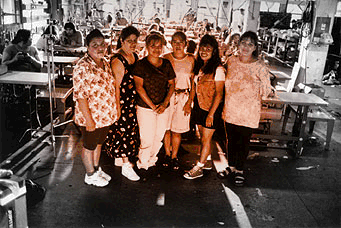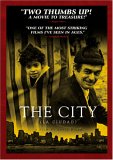| Reviews & Columns |
|
Reviews DVD TV on DVD Blu-ray 4K UHD International DVDs In Theaters Reviews by Studio Video Games Features Collector Series DVDs Easter Egg Database Interviews DVD Talk Radio Feature Articles Columns Anime Talk DVD Savant Horror DVDs The M.O.D. Squad Art House HD Talk Silent DVD
|
DVD Talk Forum |
|
|
| Resources |
|
DVD Price Search Customer Service #'s RCE Info Links |
|
Columns
|
|
|
City, The

The Film:
America is a nation of immigrants. Each and every one of them with a story, often successful, often disappointing, sometimes filled with pain. While some of these stories see the light of day retelling incredible human triumphs many remain buried deep into the hearts of those that are either unwilling to share them or are simply not given the chance to speak out. In an attempt to partially reveal the true look of modern day America, from the sweatshops in the backyards of New York to the daily struggle for survival on the outskirts of the city, director David Riker offers a glimpse at the American dream…stripped of glamour, bitter, yet still attractive for many.
La Ciudad a. k. a The City is a near documentary feature based upon four short stories depicting the struggles of Latin immigrants in New York City. Each story offers a fascinating look at the immigrant experience and according to the director is performed by real immigrants that could be found on the streets of urban America.
The first story, Bricks, is about a group of Latin immigrants and their struggle to find daily work. On a street corner in New York City they are offered 50$ each to stock bricks on an abandoned industrial building on the outskirts of the city. The few lucky enough to be selected to work are shipped in a white truck which takes them to an unknown location. Upon arrival the "contractor" announces that instead of the promised 50$ they will be paid .15 cents per brick at the end of the night and then he leaves. While trying to clean and stock the bricks from a half-way demolished industrial building a wall collapses and kills one of the workers.
The second story, Home, is about a young Mexican boy that arrives in New York City looking for his uncle. Relying only on a piece of paper with an address which appears outdated he is unable to find his relative. Disappointed the young boy walks into a nearby wedding party which seems to be playing a familiar Mexican song. There he meets a girl which against all odds happens to be from his home town. They go back to her apartment where he spends the night. On the following morning the boy decides to buy some breakfast before the girl wakes up. He goes out to the nearby deli filled with joy and somewhat happy to be able to find a familiar face in a place so far away from home. Unfortunately the boy is unable to find his way back to the apartment.
The third story, The Puppeteer, shows an older man living in an abandoned car with his little daughter dreaming that one day he will be able to enroll her in a local public school. The puppeteer manages to make ends meet by putting together amateurish street performances that sometimes bring change from thankful audiences. Unfortunately, the money is not enough and the old man's health is quickly deteriorating.
The fourth story, Seamstress, is about a woman working in a sweat shop somewhere in the heart of the city. Run by an Asian man who has not paid its workers in months the shop is filled with Mexican immigrants which appear to be undocumented. Those that question the Asian man about their paychecks are quickly dealt with and kicked out of the "factory".
After a long day at work a young Mexican woman is told that back home her daughter is seriously ill. The family needs 400$ in order for the girl to be admitted in a local hospital. The woman faces a chilling dilemma, to ask for her money and risk being sacked or keep her job and risk the life of her daughter.
David Riker's The City is unlike many of the films I have seen this year. A bold, realistic, and painful to watch this American film is a stunning accomplishment. There is very little in The City that one could criticize. Shot in simple black and white this is a film that is as real as it gets. Relying mostly on amateur actors and real immigrants the director has recreated a fraction of the American dream which we simply choose to ignore. Let's just admit it…no one wants to see a film that instead of transporting you away from your daily inconveniences puts you in an environment that seems like a horrific news report from a third world country. Well, unfortunately this is America and whether we choose to ignore it or not these people are among us. So are their stories.
How Does the Film Look? How Does the Film Sound? Extras: Final Thoughts:
Well, this specific release is not among New Yorker's best nor it is a disappointment. I am simply grateful that the film is available on the market. A truly remarkable American production that puts hope back into my heart as I am now convinced that when American directors want they could deliver spectacular films. HIGHLY RECOMMENDED.
|
| Popular Reviews |
| Sponsored Links |
|
|
| Sponsored Links |
|
|
| Release List | Reviews | Shop | Newsletter | Forum | DVD Giveaways | Blu-Ray | Advertise |
|
Copyright 2024 DVDTalk.com All Rights Reserved. Legal Info, Privacy Policy, Terms of Use,
Manage Preferences,
Your Privacy Choices | |||||||













